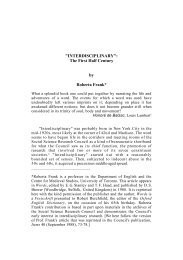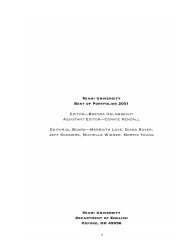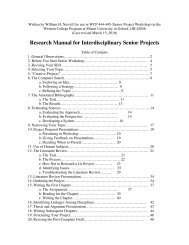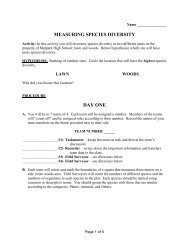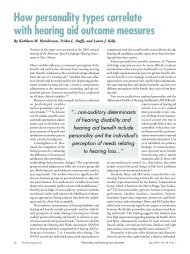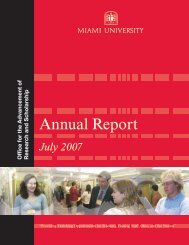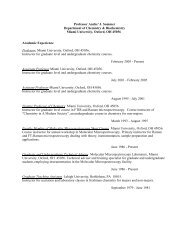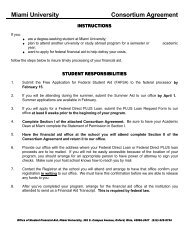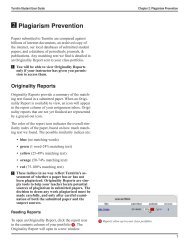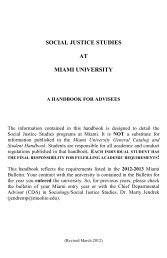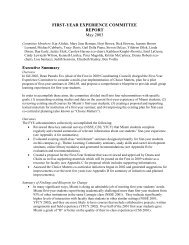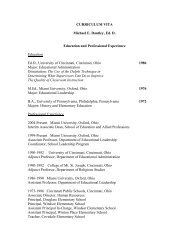DRAFT – PLEASE DO NOT CITE OR ... - Units.muohio.edu
DRAFT – PLEASE DO NOT CITE OR ... - Units.muohio.edu
DRAFT – PLEASE DO NOT CITE OR ... - Units.muohio.edu
You also want an ePaper? Increase the reach of your titles
YUMPU automatically turns print PDFs into web optimized ePapers that Google loves.
<strong>DRAFT</strong> <strong>–</strong> <strong>PLEASE</strong> <strong>DO</strong> <strong>NOT</strong> <strong>CITE</strong> <strong>OR</strong> CIRCULATE WITHOUT PERMISSION<br />
Jesse D. Murray<br />
The Transformative Russian Empire and the Development of Lamaism and<br />
Shamanism as Categories of Buryat Religion<br />
In 1881, an annual report on missionary activities dramatically referred to the<br />
construction of a church along the Russian/Chinese border as a bulwark against the<br />
“moral enslavement [of the Buryats] by an outside influence” and “gloom born from<br />
neighboring pagan countries.” 1 The church’s concern was the spread of lamaism to<br />
Buryats in the Baikal region from neighboring Mongolia, at that time a Chinese territory.<br />
At first glance, this statement would seem to suggest that lamaism was a religion from<br />
outside Russia’s borders being carried into Russia by foreign means. However,<br />
underlying the dramatic language was an understanding of Buryat history and the<br />
Buryats’ relationships to the Mongols that implied that lamaism was anything but foreign<br />
to the Buryats.<br />
Lamaism came to be treated as a key marker of both foreignness to the empire<br />
and Buryatness by means of a series of historical and religious investigations undertaken<br />
by the Baikal missionaries in the second half of the nineteenth century. Drawing on<br />
circulating ideas about the Russian Empire’s space and population, the missionaries used<br />
lamaism and shamanism, the former a staple of imperial confessional governance in the<br />
region, as categories through which they could explore processes of imperially-sponsored<br />
historical development among the Buryats. Identifying evidence of such processes among<br />
shamanist Buryats, the missionaries associated shamanism with a Buryat primitivity that<br />
was in decline thanks to progress brought to the area by the empire. Lamaist Buryats,<br />
1 “Otchet o sostoianii i deiatel’nosti Zabaikal’skoi dukhovnoi missii za 1880-i god,”<br />
PIEV, 1 August 1881, 354-355.<br />
1
<strong>DRAFT</strong> <strong>–</strong> <strong>PLEASE</strong> <strong>DO</strong> <strong>NOT</strong> <strong>CITE</strong> <strong>OR</strong> CIRCULATE WITHOUT PERMISSION<br />
however, were seen as standing outside of such historical processes; their religion tied<br />
them to the Buryats’ primitive Mongolian past, but also prevented the empire from<br />
having any beneficial impact on them. 2 Even as the categories became staples for<br />
identifying and describing the nature of Buryatness, they became key methods through<br />
which missionaries understood and explained the nature of the Russian Empire. Using<br />
lamaism and shamanism, the missionaries elucidated an understanding of empire as a<br />
developmental process, linked to but not identical to empire as a territorial construct. This<br />
model allowed groups such as lamaist Buryats to be seen as unquestionably resident<br />
within the boundaries of the empire’s territory and not be seen as threats to the empire’s<br />
political integrity, even as they presented an unacceptable degree of foreignness to other<br />
methods of imagining the empire.<br />
Missionary Descriptions of Buryat Religion<br />
In the second half of the nineteenth century, “empire” existed as a geographical<br />
space defined by negotiated political borders and populated, at least in its borderlands, by<br />
individuals defined as Russian subjects through treaties. Having been confirmed as<br />
Russian subjects resident within the empire’s boundaries by the 1727 Treaty of Kiakhta,<br />
negotiated between Russia and China, and given the lack of political threat to Russian<br />
sovereignty in the region, migrants to the region who espoused lamaism were<br />
unquestionably Russian subjects under such a definition. However, by this period, among<br />
Russians actively considering the relationship of Russia and Russians to the empire’s<br />
2 In this respect, my findings parallel those of Dittmar Schorkowitz, who argues that<br />
developmental concerns informed Russian state policies towards lamaism in the second<br />
half of the nineteenth century. Schorkowitz, “The Orthodox Church, Lamaism and<br />
Shamanism,” 205-207.<br />
2
<strong>DRAFT</strong> <strong>–</strong> <strong>PLEASE</strong> <strong>DO</strong> <strong>NOT</strong> <strong>CITE</strong> <strong>OR</strong> CIRCULATE WITHOUT PERMISSION<br />
subject peoples and territories, “empire” also signified an imagined space in which<br />
diverse imperial subjects were united by what Mark Bassin has labeled a “supra-ethnic”<br />
Russian identity. 3 For the missionaries, this space did not yet exist: it had to be created by<br />
transforming the Buryats, a process they believed had begun, but was not yet complete.<br />
But the transformative work of empire required that the Buryats be transformable. They<br />
had to be open to cultural change and advancement. Lamaism threatened this<br />
developmental arc. By reinforcing the Buryats’ most primitive social characteristics to<br />
the point of inflexibility, it removed those who espoused it from the transformative<br />
empire, even as they remained within the political empire. Consequently, “the empire” as<br />
the missionaries saw it effectively had two different borders in the Baikal region: one<br />
between Russia and China, and another between shamanist Buryats and lamaist Buryats<br />
that moved westward with the rapid spread of lamaism during the nineteenth century.<br />
As Bassin points out, visions of the empire as united by patterns of common<br />
culture and a certain geographical unity were unstable. The far eastern Amur region was<br />
imagined from Russia’s center as an untouched and pristine extension of Russian<br />
potential in the wake of the region’s incorporation into Russian territory in the 1840s.<br />
Siberian regionalists and Russian settlers undermined this vision by describing the brutal<br />
realities of life in the region for Russian immigrants, instead depicting the region as<br />
belonging to Russia through the historical experience of “being osvoeny, that is occupied<br />
and brought into the realm of civilization and “historical movement” (to use the phrase of<br />
3 Mark Bassin, “Geographies of Imperial Identity,” in The Cambridge History of Russia:<br />
Imperial Russia, 1689-1917, ed. Dominic Lieven (Cambridge: Cambridge University<br />
Press, 2006), 55-59.<br />
3
<strong>DRAFT</strong> <strong>–</strong> <strong>PLEASE</strong> <strong>DO</strong> <strong>NOT</strong> <strong>CITE</strong> <strong>OR</strong> CIRCULATE WITHOUT PERMISSION<br />
the day) by the Russians.” 4 Similarly, pan-Slavist geographers examining the empire<br />
from their base at its center excluded newly-conquered territories in the Far East and<br />
Central Asia from the empire as a cultural entity because they were “extraneous<br />
historically, ethnographically, and physically.” Instead, they were Russian purely “by<br />
virtue of their political subjugation to Russia.” 5<br />
Maintaining the image of the empire as<br />
possessing an inherent cultural unity thus required a number of intellectual contortions, in<br />
which ideas of historical progress and outright exclusion were particularly powerful tools.<br />
The missionaries, driven by the goal of incorporating the Buryats into the “supraethnic”<br />
empire, used shamanism and lamaism as categories through which they could<br />
explore their successes and the obstacles that they faced. The Buryats had a lengthy<br />
history within the empire and had been classed by the 1822 Siberian Statute as a group<br />
that had at least partially advanced beyond its primitive roots. 6 The sharp distinction that<br />
the missionaries created between civilizable shamanist Buryats and irreconcilably foreign<br />
lamaist Buryats suggests that the intellectual processes of imperial construction described<br />
by Bassin resulted not only in the exclusion or conceptual instability of territories that<br />
were new to the empire, but called into question territories and groups of people who had<br />
long been part of the empire. The missionaries coped with the questionable relationship<br />
of the Buryats to the Russian Empire through the construction of religious categories that<br />
distinguished between Buryats who challenged the missionaries’ vision of the empire and<br />
4 Mark Bassin, Imperial Visions: Nationalist Imagination and Geographical Expansion<br />
in the Russian Far East, 1840-1865 (Cambridge: Cambridge University Press, 1999), 4-<br />
14, 233-237, 268-270.<br />
5 Mark Bassin, “Russia between Europe and Asia: The Ideological Construction of<br />
Geographical Space,” Slavic Review 50, no.1 (Spring 1991): 12-13.<br />
6 On the correspondence between perceived state of social sophistication and legal<br />
position within the Siberian Statute, see Hundley, “Speransky and the Buriats,” 34-38,<br />
and Raeff, 116-117.<br />
4
<strong>DRAFT</strong> <strong>–</strong> <strong>PLEASE</strong> <strong>DO</strong> <strong>NOT</strong> <strong>CITE</strong> <strong>OR</strong> CIRCULATE WITHOUT PERMISSION<br />
those who offered evidence of the inevitable success of their vision. This supports Paul<br />
Werth’s assertion that the movement towards a national model of envisioning the empire<br />
“required the definition of “alien” elements.” As earlier, more complex bureaucratic<br />
terminologies of differences collapsed into the single term of inorodets, simply signifying<br />
a not-necessarily-pejorative otherness, “newer epistemologies of difference” gained<br />
prominence. These were intimately linked to shifting ideas about the nature of the<br />
Russian Empire, as they supported distinctions between non-Russian imperial subjects<br />
who were “understood to be different from Russians but amenable to assimilation” and<br />
“’colonial subjects’ (those who were so different and/or uncivilized that they should be<br />
administered in a particularistic fashion) and for whom assimilation was not possible.” 7<br />
The categories of shamanism and lamaism were iterated through a range of<br />
descriptive writings that aimed to explain what the two were, how each related to Buryat<br />
history, and how they were reflected in and informed Buryat social and cultural practices.<br />
To this end, the missionaries’ works appear representative of a genre that David<br />
Chidester has labeled “frontier comparative religion,” a “human science of local control.”<br />
Chidester, focusing on southern Africa in the mid-nineteenth century, argues that local<br />
representatives of colonial power, including many missionaries, drew on emergent<br />
techniques of scientific description to produce “discourse[s] about others that reinforced<br />
their colonial containment” by identifying and describing local religion as such. During<br />
the nineteenth century, lamaism spread rapidly, both in terms of the growth of new<br />
datsans and the growth in the number of Buryats who were listed on state-maintained<br />
confessional records as its adherents; the areas in which lamaism was believed to be<br />
7 Werth, At the Margins of Orthodoxy, 124-139.<br />
5
<strong>DRAFT</strong> <strong>–</strong> <strong>PLEASE</strong> <strong>DO</strong> <strong>NOT</strong> <strong>CITE</strong> <strong>OR</strong> CIRCULATE WITHOUT PERMISSION<br />
strongest and most deeply entrenched were the areas that the mission saw as particularly<br />
hostile to its activities. In this context, relegating lamaism, the social and cultural<br />
practices that were seen as linked to it, and lamaists to the status of exceedingly primitive<br />
and fundamentally irredeemable served to exclude a population that was, unquestionably,<br />
part of the Russian Empire, from processes of change that the empire was intended to<br />
bring about. This division both absolved the empire of its failure to bring transformation<br />
and retrenched the idea of imperial transformation as an inevitable process to regions in<br />
which such change was a more intellectually tenable possibility. As Chidester points out,<br />
such intellectual endeavors produced bodies of knowledge that were “embedded in local<br />
colonial situations.” 8<br />
In this respect, my work provides insight into the debated question of lamaism’s<br />
place within the empire. Dittmar Schorkowitz and H.S. Hundley have approached this<br />
question through explorations of state attempts to control lamaist structures, and reached<br />
very different conclusions. Schorkowitz finds that between the early eighteenth and late<br />
nineteenth centuries, the state, informed by missionary reports and lobbying, shifted from<br />
viewing lamaism as a sophisticated and potentially civilizing force that should be allowed<br />
to proselytize shamanists to treating it as an obstacle to the success of civilizing efforts<br />
oriented towards christianization. Providing historical background to this shift,<br />
Schorkowitz argues that the period was one of intense social change among the Buryats,<br />
in which shamanism, a religion intimately linked to less-complex, communal social<br />
structures that were changing as a result of contact with Russians, was in a period of<br />
8 David Chidester, Savage Systems: Colonialism and Comparative Religion in Southern<br />
Africa (Charlottesville: University of Virginia Press, 1996), 2-3.<br />
6
<strong>DRAFT</strong> <strong>–</strong> <strong>PLEASE</strong> <strong>DO</strong> <strong>NOT</strong> <strong>CITE</strong> <strong>OR</strong> CIRCULATE WITHOUT PERMISSION<br />
rapid decline, a situation of which Russian authorities were aware. 9 Hundley, whose<br />
limited base of primary sources is strongly oriented towards missionary publications,<br />
finds that the state always saw lamaism as an external force that threatened to undermine<br />
its control of the region, and treated it as such in regulations. Analyzing the mission’s<br />
concerns, she suggests that missionaries believed that shamanism was less developed,<br />
while lamaism was more sophisticated and consequently more threatening to state and<br />
church interests. 10 The representations of lamaism as an obstacle and a foreign force and<br />
shamanism as a declining religion linked to simplistic social structures that were in a state<br />
of change on which Schorkowitz and Hundley rely were the products of attempts to<br />
grapple with the challenges the Buryats presented to the construction of empire as a<br />
“supra-ethnic” entity. Rather than impartial observations, such beliefs and the<br />
observations mustered to support them were intimate parts of the knowledge<br />
constructions that Chidester argues were inextricable from the local reproduction of<br />
imperial authority. Consequently, they cannot be taken as transparent statements of fact.<br />
Given that Orthodox missionary writings remain a key source for contemporary<br />
investigations of pre-revolutionary shamanism and, to a certain extent, lamaism, this calls<br />
into question the degree to which contemporary academics can claim any sort of real<br />
knowledge about the religious practices and social systems of the Buryats, or, for that<br />
matter, other Siberian peoples. 11 Indeed, Caroline Humphrey suggests that it is disputable<br />
9 Schorkowitz, Staat und Nationalitäten, 43-69.<br />
10 Hundley, “Defending the Periphery,” 231-250.<br />
11 As an example of the heavy representation of missionary descriptive works within the<br />
contemporary source base for analysis of nineteenth-century shamanism, approximately<br />
twenty percent of the authors discussed in Andrei A. Znamenski’s annotated bibliography<br />
of significant ethnographic sources on the subject, Shamanism in Siberia: Russian<br />
7
<strong>DRAFT</strong> <strong>–</strong> <strong>PLEASE</strong> <strong>DO</strong> <strong>NOT</strong> <strong>CITE</strong> <strong>OR</strong> CIRCULATE WITHOUT PERMISSION<br />
whether lamaism and shamanism can reasonably be treated as discrete categories of<br />
religious practice among Mongols and Buryats, and a growing body of scholarship points<br />
to the idea that the category “shamanism” itself is a western intellectual construct. 12<br />
Many assessments of shamanism among the Buryats in the late nineteenth century rely on<br />
either state-maintained statistics on religious confession, or descriptive reports such as<br />
those of the missionaries. 13 Government statistics provide an inadequate guide to<br />
religious change, simply correlating a drop in reported numbers of shamanists with an<br />
increase in reported numbers of lamaists. 14 This offers no window into the religious<br />
practice of ordinary Buryats, instead reflecting both the state’s belief that one individual<br />
could not profess multiple confessions and the ascriptive practices of the Buryat officials<br />
who maintained such records. As I suggest here, narrative reports are also unreliable<br />
indicators of the religious practice of ordinary Buryats, reflecting the anxieties and<br />
agendas of their authors as much as what evidence those authors did see; this was as true<br />
of Buryat ethnographers attempting to explain their subjects to a Russian audience as it<br />
Records of Indigenous Spirituality (Dordrecht: Kluwer Academic Publishers, 2003), were<br />
Russian Orthodox missionaries.<br />
12 Humphrey, 243, 248-251. On shamanism as a western intellectual construct, see<br />
Ronald Hutton, Shamans: Siberian Spirituality and the Western Imagination (London:<br />
Hambledon & London, 2002), vii-viii, and Andrei A. Znamenski, The Beauty of the<br />
Primitive: Shamanism and Western Imagination (Oxford: Oxford University Press,<br />
2007).<br />
13 For a description-based work, see Mikhailov, “Vliianie,” 127-149, a remarkable<br />
attempt, considering the time of its production, to reconstruct how lamaism and<br />
Christianity affected Buryat shamanism. Approximately half of Mikhailov’s sources were<br />
written by Orthodox missionaries. Statistics-based approaches include Hundley,<br />
“Defending the Periphery,” and Schorkowitz, Staat und Nationalitäten.<br />
14 For an overview of government-maintained statistics on religious confession in the<br />
Baikal region in the second half of the nineteenth century, see Hundley, “Defending the<br />
Periphery,” 248-249.<br />
8
<strong>DRAFT</strong> <strong>–</strong> <strong>PLEASE</strong> <strong>DO</strong> <strong>NOT</strong> <strong>CITE</strong> <strong>OR</strong> CIRCULATE WITHOUT PERMISSION<br />
was of missionaries. 15 Using the current Russian-oriented source base, it is extremely<br />
difficult, and possible only in small fragments that are difficult to place in an interpretive<br />
context, to determine what the religious landscape of the Baikal region in the nineteenth<br />
century truly looked like. The simple fact is that we do not know what most Buryats<br />
“truly” believed or what they did away from observers in their homes and fields.<br />
In addition to reflecting fears, anxieties, and hopes about the relationship between<br />
the Buryats and the empire in its various manifestations, the missionaries’ writings can be<br />
read as an extended exploration of the proper place of religion in society. As Anthony<br />
Pagden argues regarding the ethnologies of early Catholic missionaries to the New<br />
World, conceptual scales of development made their explorations of New World societies<br />
into comparative endeavors that were partially intended as meditations on the<br />
missionaries’ society of origin. 16 While this process was not quite as overt among the<br />
Baikal missionaries, the missionaries’ hope of transforming the region in the image of<br />
Russia made their explorations of lamaism and shamanism into considerations of an early<br />
stage of human development and the distinctions between what they perceived among the<br />
Buryats and what they believed the nature of Russian society to be. That the missionaries<br />
believed the Russians stood at the endpoint of the developmental process that the Buryats<br />
15 Alternate sources include works by members of the Buryat intelligentsia, including<br />
Matvei Nikolaevich Khangalov, who was active during the late nineteenth century, and a<br />
large clump of Russian and Buryat nationalist scholars including Tsyben Zhamtsarano,<br />
D.A. Klements, and M. Krol’, who, as Vera Tolz demonstrates in Russia’s Own Orient:<br />
The Politics of Identity and Oriental Studies in the Late Imperial and Early Soviet<br />
Periods (New York: Oxford University Press, 2011), 111-134, were themselves pursuing<br />
a research agenda shaped by their ambitions for the Buryats.<br />
16 Anthony Pagden, The Fall of Natural Man: The American Indian and the Origins of<br />
Comparative Ethnology (Cambridge: Cambridge University Press, 1982), 3-4, 150.<br />
Ronald Hutton makes a similar argument about shamanism specifically, arguing that its<br />
description functioned as a method through which “modern western civilization has<br />
defined itself.” Hutton, viii.<br />
9
<strong>DRAFT</strong> <strong>–</strong> <strong>PLEASE</strong> <strong>DO</strong> <strong>NOT</strong> <strong>CITE</strong> <strong>OR</strong> CIRCULATE WITHOUT PERMISSION<br />
were beginning is evident from their repetitive proffering of Russian history as an<br />
example for the benefits that eschewing lamaism could provide to the Buryats. Members<br />
of the mission referred to stories about the baptism of Rus’ and the selection of<br />
Christianity by Grand Prince Vladimir of Kiev as evidence of the potential outcome of<br />
the choice between religions faced by the Buryats, imbuing their with the forward<br />
momentum of human development. The conversion of Kievan Rus’ was upheld as a<br />
triumph of the intellect over “their previous faith” and a great feat of leadership, a careful<br />
selection of the best religion from among the rest, and the choice of the most beautiful<br />
and sophisticated religion that the world had to offer, with the unspoken implication that<br />
lamaism was ugly, uncultured, and the choice of a backwards leadership oriented towards<br />
primitivity. 17 By telling the story of Vladimir in the context of the developmental crisis of<br />
the Buryats, the archbishops suggested that, faced with a choice between development<br />
and stagnation, Russia had chosen correctly, and thus stood as a living example of what<br />
the Buryats stood to gain or lose by pursuing or refusing to pursue development. In short,<br />
the Buryats had a choice: they could choose to be Russian, or they could choose to be<br />
uncivilized.<br />
In light of this deliberate degree of self-reflection in the missionaries’<br />
understandings of what would constitute progress and development among the Buryats,<br />
the missionaries’ writings appear as an implicit critique of Buryat society for lacking<br />
positive attributes they believed Russian society possessed. In the process of describing<br />
17 Veniamin, Zhiznennye voprosy, 19; "Poezdka Vysokopreosviashchenneishego<br />
Serafima, Arkhiepiskopa Irkutskogo i Verkholenskogo v Tunku,” PB, no. 23-24<br />
(December 1913): 723; "Obozrenie stanov i prikhodov Verkholenskogo uezda<br />
nachal'nikom Irkutskoi dukhovnoi missii episkopom Zosimoiu v oktiabre 1916 goda,”<br />
PB, no. 1-4 (1917): 200-201.<br />
10
<strong>DRAFT</strong> <strong>–</strong> <strong>PLEASE</strong> <strong>DO</strong> <strong>NOT</strong> <strong>CITE</strong> <strong>OR</strong> CIRCULATE WITHOUT PERMISSION<br />
what they saw as the intertwined relationship between shamanism and lamaism and the<br />
respective social and cultural practices of western and eastern Buryats, the missionaries<br />
made a number of critiques of shamanism and lamaism that reveal their understandings<br />
of the proper place that religion should occupy in society, and the role that it performed<br />
in development. 18 A chief criticism of both shamanism and lamaism leveled by the<br />
missionaries was that the two were all-encompassing, governing every aspect of their<br />
believers’ daily lives. This expressed itself particularly in repeated assertions about the<br />
misleading and deceptive beliefs characteristic of lamaism and shamanism in regards to<br />
health and medicine, but also through criticisms of Buryat herding practices, seen as<br />
dictated by lamas and linked to lamaism, as inefficient. The missionaries’ assertion in this<br />
regard was that lamas and shamans claimed to possess truths and powers in these matters<br />
that modern science had proven that they did not have. In short, they possessed authority<br />
that, in a civilized society, was best left to doctors and agriculturalists. Indeed, the<br />
missionaries viewed the distribution of medicine and factual information about disease<br />
and animal husbandry as some of their best weapons against both shamans and lamas.<br />
In some respects, this reflects the trend among Orthodox missionaries in the<br />
second half of the nineteenth century of justifying their work and their requests for state<br />
and popular support by proclaiming their role in “larger processes of assimilation and<br />
civilizing.” This argument has been understood by historians as an assertion that<br />
18 The missionaries openly argued that they treated religion and way of life as<br />
coterminous because the Buryats saw them so; this would seem to support Paul Werth’s<br />
contention that the late nineteenth century saw an Orthodox missionary movement<br />
towards distinguishing faith or belief from way of life. Werth, At the Margins of<br />
Orthodoxy, 144-145. However, the overall content of their writings suggest that they<br />
themselves consistently linked the two, perhaps because they had been unable to find a<br />
metric that was not focused on what were labeled as external manifestations of internal<br />
belief to determine the authenticity of conversions.<br />
11
<strong>DRAFT</strong> <strong>–</strong> <strong>PLEASE</strong> <strong>DO</strong> <strong>NOT</strong> <strong>CITE</strong> <strong>OR</strong> CIRCULATE WITHOUT PERMISSION<br />
absorption of Christian values would predispose converts to adopt a number of practices<br />
that the state wished to disseminate among the empire’s inhabitants. 19 The missionaries’<br />
critiques of the Buryats’ adherence to “superstition” over science suggest that their<br />
imagining of this path of forward development may have been less linear than such<br />
interpretations of their words might presuppose. While the missionaries did argue that<br />
adherence to Christianity predisposed converts to adopt certain types of law, the same<br />
group of authors suggested in their writings about Buryat superstition that an acceptance<br />
of scientifically-informed practices was a necessary precursor to the acceptance of<br />
Christianity. Superstition had to be displaced by science before Orthodoxy could spread<br />
among the Buryats. If, as Pagden might suggest, this can be read as a statement of the<br />
missionaries’ beliefs about the relationship between the place of religion and secular<br />
knowledge in Russian society, it appears that the missionaries envisioned a Russian<br />
society in which religion and religious belief existed in a distinctly separate sphere of life<br />
from scientific knowledge. The two could be mutually supporting, but were seen as<br />
dealing with very different, and mutually exclusive, realms of human experience.<br />
Particularly curious about the missionaries’ descriptions of Buryat religion is the<br />
lack of chronological change evident in them. Once the missionaries had grappled with<br />
the issue of the Buryats’ internal diversity and its significance to the mission and<br />
established a framework within which these problems could be understood, that<br />
framework remained remarkably stable. The missionaries continued to interpret lamaism<br />
as a threat to the integrity of the transformative empire from within the borders of the<br />
political empire even as concern in central Russia about the insecurity of the region in the<br />
19 Werth, At the Margins of Orthodoxy, 141.<br />
12
<strong>DRAFT</strong> <strong>–</strong> <strong>PLEASE</strong> <strong>DO</strong> <strong>NOT</strong> <strong>CITE</strong> <strong>OR</strong> CIRCULATE WITHOUT PERMISSION<br />
context of the “yellow peril” and the Russo-Japanese War spiked. 20 This was because the<br />
depiction of lamaism as a force that reiterated and justified Buryats’ connection to their<br />
roots proved an adequate conceptual means of explaining the perceived local<br />
manifestation of these events, namely the threat that the Buryats would begin to view<br />
themselves as a distinct nationality not bound in cultural union with Russia. Local<br />
authorities, whether church or government, never viewed the region as being at risk of<br />
secession or overt uprising against Russian governmental authority, and the government<br />
did not believe that either the Chinese or Mongolian authorities planned to challenge the<br />
border. Buryat nationalism was seen by local authorities who hewed to a vision of the<br />
empire as a transformative force as a threat to that vision of the empire, not to the<br />
empire’s political integrity.<br />
The Origins of the Buryats<br />
The missionaries had no doubt about the Buryats’ historical relationship to the<br />
Mongolic peoples residing outside of Russia’s borders. Most missionary authors who<br />
wrote about Buryat history touched on the fact that “the Buryats” had originally been a<br />
20 The metropolitan missionary periodical Pravoslavnyi blagovestnik republished two<br />
1911 articles from Novoe vremia that framed lamaism as a threat to the political borders<br />
of the Russian Empire, once arguing that a Japanese count and leader of a “Buddhist<br />
sect” had sent a scientific expedition into the Baikal region “with the goal of uniting the<br />
Buddhists of Mongolia, China, India, and Japan” as well as the Buryats and Kalmyks,<br />
and once declaring that lamaism could become “political” and threatened to unite the<br />
Buryats with “foreign [zarubezhnaia] Mongolia.” The fact that the articles were<br />
republished in Pravoslavnyi blagovestnik, the Moscow-based journal of the Orthodox<br />
Missionary Society, indicates that such sentiments had traction with metropolitan church<br />
authorities; however, these sentiments found very little reflection in missionary<br />
discourses about lamaism’s threat. “Iapontsy u buriat,” PB, no. 2 (January 1911): 87-88;<br />
“Zabaikal’skoe lamstvo,” PB, no. 16 (August 1911): 165.<br />
13
<strong>DRAFT</strong> <strong>–</strong> <strong>PLEASE</strong> <strong>DO</strong> <strong>NOT</strong> <strong>CITE</strong> <strong>OR</strong> CIRCULATE WITHOUT PERMISSION<br />
diverse, if culturally interrelated, set of Mongolic tribes that had migrated across what<br />
eventually became the Russian/Chinese border to settle in the Baikal region. Most<br />
authors concurred that these migrations had taken place across centuries, with different<br />
groups arriving at different times and consequently possessing a different cultural<br />
makeup, although many did not bother to trace the migrations in detail back past the time<br />
of Russian arrival in the region in the 1640s.<br />
The missionaries believed that the degree of contact that various Buryat groups<br />
had with their Mongolian cousins was key to understanding the sharp differences among<br />
the Buryats. I. A. Podgorbunskii, a missionary writing in the early twentieth century,<br />
argued that up to, as well as under, Russian control, the “composition of the Buryat<br />
population…significantly changed.” Within Podgorbunskii’s formulation of the origins<br />
of the Buryats, movement in and out of the Baikal region by Mongolic groups began as<br />
early as the twelfth century, and was at times accelerated by historical events, such as the<br />
period of Chinggis Khan’s rise to power and the Mongol conquests in Asia and Europe.<br />
Eventually, a northern, forest-dwelling Mongolic group began to refer to themselves as<br />
buriaty, although presumably not in a Russian-inflected plural form. These, in turn,<br />
referred to subsequent arrivals by other names, thus deliminating a boundary between the<br />
Buryats, who had lived in the region longer, and more recent arrivals such as the Khori.<br />
The process of cultural differentiation between dwellers in the Baikal region and what<br />
Podgorbunskii described as their “Mongolian relatives [Mongol’skie soplemenniki]” took<br />
place as a natural result of time, but accelerated under the advent of Russian rule in the<br />
seventeenth century. However, differentiation occurred differently for different groups<br />
within the Baikal region: the “north Baikal” Buryats, who had lived in the area for longer,<br />
14
<strong>DRAFT</strong> <strong>–</strong> <strong>PLEASE</strong> <strong>DO</strong> <strong>NOT</strong> <strong>CITE</strong> <strong>OR</strong> CIRCULATE WITHOUT PERMISSION<br />
were separate from the “south Baikal” Buryats, who continued to be augmented by<br />
migration from Mongolia. Podgorbunskii asserted that the latter group only became<br />
known as “Buryats” when they were labeled as such by the Russian government; the<br />
former group was “Buryat in the true sense.” 21<br />
Among missionaries who took a historical view of the assemblage as an entity of<br />
the Buryats, the southern Buryats, more Mongol than the northern Buryats, were seen as<br />
the carriers of lamaism. Their Mongolianness and their ties to lamaism were intimately<br />
related. One author argued that the Muscovite government had, in the seventeenth<br />
century, required the Mongol Buryats to refer to themselves strictly as Buryats (either<br />
buriaty or bratskie muzhiki) in order to sever links with the Mongols and prevent the<br />
arrival of lamaism from Mongolia. 22<br />
Similarly, Meletii, the one-time head of the mission<br />
to the southern Buryats, repeatedly described the Selenga and Khori Buryats, more recent<br />
migrants to the area who resided in the south Baikal region, as “Mongols,” and argued<br />
that lamaism was endemic among the Mongols. There were dissenters: some<br />
missionaries, primarily those writing criticisms of government policy, occasionally<br />
described lamaism as something brought across the Russian/Chinese border by<br />
foreigners. However, even authors who leveled this charge would make assertions<br />
21 I.A. Podgorbunskii, “Buriaty: Istoricheskii ocherk,” PB, no. 18 (September 1902): 87,<br />
and no. 19 (October 1902): 121-123. Other authors who took a similarly long view of<br />
Buryat coalescence while still emphasizing the essential Mongolianness of the southern<br />
Buryats included Nil (Iaroshevich), in Buddizm: razsmatrivaemyi v otnoshenii k<br />
posledovatel’iam ego, obitaiushchim v Sibiri (St. Petersburg: Tipografiia Grigoriia<br />
Trusova, 1853), 5-8; and Meletii, in Pravoslavie i ustroistvo tserkovnykh del v Daurii<br />
(Zabaikal’e), Mongolii i Kitae v XVII i XVIII stoletiiakh (Riazan: Tipografiia Bratstva sv.<br />
Vasiliia, 1901).<br />
22 V.V. N-ii, “Bor’ba pravoslavnoi missii v Zabaikal’e s lamaizmom,” PB, no. 1 (January<br />
1903): 33. To the best of my knowledge, such a regulation never existed; this may have<br />
been an interpretation of the government’s intent in referring to the southern Buryats in<br />
such terms in a treaty.<br />
15
<strong>DRAFT</strong> <strong>–</strong> <strong>PLEASE</strong> <strong>DO</strong> <strong>NOT</strong> <strong>CITE</strong> <strong>OR</strong> CIRCULATE WITHOUT PERMISSION<br />
suggesting that lamaism was native to some segments of the Buryats as a result of their<br />
cultural and historical ties to Mongolia. 23<br />
The missionaries believed that just as different waves of migration into the<br />
Baikal region had built the Buryats as a naturally diverse group, cross-border contact had<br />
continued to connect the Buryats to both Mongolia and lamaism even after the<br />
solidification of the border through treaties. One missionary argued that cross-border<br />
migration since the 1727 Kiakhta Treaty had altered the composition of the Tunka<br />
Buryats: “Emigres from Mongolia have enlarged the population more than a little, and no<br />
one has investigated them or asked where they are from and why they have come.” 24<br />
Concerns about the cross-border connections of the Tunka Buryats were particularly<br />
prevalent, as the missionaries argued that the region’s mountainous and swampy<br />
landscape made access to Mongolia comparatively easier than access to the Irkutsk<br />
region, just to the north of the Tunka Valley. 25 Similarly, they found that in the Aginsk<br />
region, the Tsongol Buryats, “living near the border, are in unbroken contact with<br />
Mongolian lamas.” 26<br />
Tracing the migration patterns that closely linked certain Buryat groups to<br />
Mongolia became a means by which the missionaries could explain lamaism’s presence<br />
23 See, for example, Afanasii Vinogradov, “O lamaizm za Baikalom,” PIEV, 30<br />
November 1885, 581.<br />
24 The word “émigré” [vykhodets] typically signified a Mongolian lama who entered<br />
Russia, gathered donations, and then left; in this case, the author was referring to<br />
laypeople who settled permanently. “Zapiski missionera Shimkovskogo stana” 3 April<br />
1882, 176-178.<br />
25 See, for example, Nikolai Stukov, "Obozrenie preosviashchennym Makariem,<br />
nachal'nikom irkutskogo otdela dukhovnoi missii, missionerskikh stanov v tunkinsome<br />
vedomstve i osviashchenie chasovni na skale Sagaugun-Syrdek,” PIEV, 11 October 1886,<br />
447.<br />
26 “Otchet o Zabaikal’skoi Pravoslavnoi missii za 1877 god. (Prodolzhenie),” PIEV, 17<br />
June 1878, 272.<br />
16
<strong>DRAFT</strong> <strong>–</strong> <strong>PLEASE</strong> <strong>DO</strong> <strong>NOT</strong> <strong>CITE</strong> <strong>OR</strong> CIRCULATE WITHOUT PERMISSION<br />
among the Buryats. However, explorations of shamanism also asserted a connection<br />
between the Buryats and Mongolia. The missionaries’ attempts to historicize Buryat<br />
shamanism used Mongolian written epics and Buryat oral epics as sources or worked to<br />
establish philological commonalities between Mongolian and Buryat shamanism. These<br />
programs of study asserted a contemporary commonality between the two types of<br />
shamanism, but also gave them a common root in the “ancient Mongols.” Such<br />
intellectual efforts served to emphasize the common cultural foundation of Buryats and<br />
Mongols, but also supported the idea that a crucial change had occurred among lamaists,<br />
Mongols, and Buryats. 27<br />
“Our Buryats” and Shamanism<br />
There was no question in the mind of the missionaries that shamanist Buryats<br />
were more promising as potential converts than lamaist Buryats. One report comparing<br />
the percentage of the population that was baptized in the shamanist Kudara region to the<br />
percentage baptized in the lamaist Onon region reached the stark figures of 47% and 6%,<br />
respectively. The report’s author had a clear explanation for this: “The Kudara<br />
missionary works with shamanists, and the other missionaries with lamaists. Between one<br />
and the other, there is nothing in common, neither in character nor in religious belief…it<br />
was easier to attract the shamanists to the faith of Christ than the lamaists.” The report’s<br />
author listed a simple reason for this sharp difference between the two: “the shamanists<br />
27 S. V. Kopylov, “Religioznaia verovaniia, semeinye obriady i zhertvoprinosheniia<br />
severobaikal’skikh buriat shamanistov,” PIEV, 21 December 1885, 620-621. I.A.<br />
Podgorbunskii, “Iz mifologii buriat i mongolov shamanistov. Tengrii,” in Sibirskii<br />
sbornik: Pribavlenie k “Vostochnomu obozreniiu,” ed. I.G. Sheshunov (Irkutsk: 1894), 2.<br />
See also Konstantin Stukov, “Vzgliad,” PIEV, 13 April 1874, 176-181.<br />
17
<strong>DRAFT</strong> <strong>–</strong> <strong>PLEASE</strong> <strong>DO</strong> <strong>NOT</strong> <strong>CITE</strong> <strong>OR</strong> CIRCULATE WITHOUT PERMISSION<br />
have neither literacy nor an organizational hierarchy, and the lamaists have both one and<br />
the other.” 28 However, the author of the report also attributed the missionaries’ success<br />
among the shamanists to the fact that shamanists were, for the most part, “indifferent to<br />
[their] faith.” 29 Behind this statement rested the idea that through centuries of contact<br />
with Russians, shamanist Buryats had developed through a slow process of social change.<br />
The missionaries believed that as shamanist Buryats became more developed and their<br />
way of life [byt’] evolved, they had outgrown their religion and were on the cusp of<br />
embracing a new religion that would match their more Russian way of life: Orthodoxy.<br />
The missionaries’ understanding of the developmental path of the shamanist<br />
Buryats depended on the geography of habitation of Podgorbunskii’s “Buryats in the true<br />
sense,” the earliest arrivals to the Baikal region. By and large, they lived in the parts of<br />
the region most densely populated with Russians: north of the city of Irkutsk, in the<br />
Barguzin Valley, and on the river networks on the southeast side of Lake Baikal. The<br />
other Buryat groups were more likely to be lamaist and live in areas near the border that<br />
were very sparsely populated with Russians. Sustained contact with the Russians over<br />
the course of centuries brought extensive changes to the “Buryats in the true sense.” 30<br />
Although it is not possible to make a universal statement about the nature of these<br />
changes, they included the curtailing or cessation of annual migrations with herds, the<br />
28 “Otchet o Zabaikal’skoi pravoslavnoi missii za 1877”, 17 June 1878, 273-275. H.S.<br />
Hundley argues that this view of lamaism as advanced and shamanism as undeveloped<br />
and weak was the key factor behind the Russian state’s and Russian Orthodox Church’s<br />
fears of lamaism; “Defending the Periphery,” 232.<br />
29 “Otchet o Zabaikal’skoi pravoslavnoi missii za 1877,” 17 June 1878, 273-275.<br />
30 For a detailed study of processes of cultural interaction, adoption and adaptation in the<br />
Baikal region, including analyses of Russian settlement patterns, see O.V. Buraeva,<br />
Etnokul’turnoe vzaimodeistvie narodov baikal’skogo regiona v XVII-nachale XX v.<br />
(Ulan-Ude: Izdatel’stvo Buriatskogo nauchnogo tsentra SO RAN, 2005).<br />
18
<strong>DRAFT</strong> <strong>–</strong> <strong>PLEASE</strong> <strong>DO</strong> <strong>NOT</strong> <strong>CITE</strong> <strong>OR</strong> CIRCULATE WITHOUT PERMISSION<br />
adoption of agriculture, shifts in patterns of food consumption, and changes in housing. 31<br />
The missionaries noted these shifts, and attributed them to the positive effects of<br />
intercultural contact sponsored by empire. As Podgorbunskii wrote, the difference<br />
between the two types of Buryats was the “degree to which they have given in to Russian<br />
influence and move along the path to cultural development.” 32 For the missionaries, these<br />
shifts were unequivocally good. They signaled that shamanist Buryats were moving to a<br />
higher stage of development, and that the missionaries would eventually meet greater<br />
success propagating their more developed religion.<br />
In the missionaries’ eyes, shamanism was a religion that resulted from a lack of<br />
<strong>edu</strong>cation and mental development. It was unsystematic, which the missionaries took to<br />
be a key indicator of its relationship to a primitive society, or it was the intellectual<br />
product of a “childlike mind”. 33 But more importantly, the solutions to problems that it<br />
provided stood in direct contradiction to civilized science and knowledge. Shamanism<br />
succeeded among the Buryats because they had no knowledge to understand or explain<br />
the true causes of the things that happened around them, whether natural phenomena or<br />
life events such as illness. Consequently, they grasped at the solutions provided by<br />
shamans, who tailored their answers to meet the developmental level of their clients,<br />
31 The Ethnographic Museum in Ulan-Ude has an excellent collection of late nineteenth<br />
century “wooden yurts” from the Irkutsk region. These structures were patterned after<br />
traditional felt yurts with their one-room, eight-sided design. Unlike the traditional yurt,<br />
which was designed to be moveable, these were immoveable, and later models included a<br />
single glass-paned window.<br />
32 Podgorbunskii, “Buriaty. (Fizicheskii tip i dukhovnaia lichnost’ buriat),” PB, no. 9<br />
(May 1903): 27.<br />
33 “Otchet o sostoianii i deiatel’nosti Irkutskoi dukhovnoi missii za 1906,” no. 12, 148.<br />
See also Meletii, “O shamanstve,” PB, no. 10 (May 1894): 51-52; and N. Komarov,<br />
“Ocherki verovanii inorodtsev, sredi kotorykh deistvuiut nashi missii,” PB, no. 1<br />
(January 1893): 27, and no. 2 (January 1893): 19-20.<br />
19
<strong>DRAFT</strong> <strong>–</strong> <strong>PLEASE</strong> <strong>DO</strong> <strong>NOT</strong> <strong>CITE</strong> <strong>OR</strong> CIRCULATE WITHOUT PERMISSION<br />
suggesting a sacrifice to propitiate whatever was causing the problem. 34 Because its<br />
practitioners and devotees were un<strong>edu</strong>cated and undeveloped people seeking answers that<br />
corresponded with their mental capacities, shamanism provided, in the words of<br />
Podgorbunskii, “little material for thought [with] so much wasted energy.” 35 As a<br />
consequence of this investment in a religion that sought spiritual solutions for problems<br />
that the missionaries viewed as having been solved by civilized science, many Buryats<br />
died when they did not have to: missionary reports were not infrequently full of accounts<br />
of deaths and suffering as a result of the implementation of shamanist solutions to<br />
scientific problems. 36<br />
As science was the solution to shamanism, the missionaries saw shamanism<br />
beginning to decline as Russian <strong>edu</strong>cation and medical practices took hold in the region,<br />
raising the developmental level of the Buryats. Arguing that the mission should receive<br />
credit for this development, Podgorbunskii asserted that the spread of missionary schools<br />
since the 1860s had resulted in an increased level of “culture” among the shamanists,<br />
making shamanism less appealing. 37 Dimitrii Gagarin, a missionary working near Irkutsk,<br />
found that shamanism was weakening among “the younger, more thinking inorodtsy.” 38<br />
The provision of medical services by missionaries was believed to play a key role in the<br />
unseating of shamanism through the promotion of science: by serving as medics and<br />
explaining the “natural causes” of an illness, missionaries could undercut the authority of<br />
34 P. A. N-skii, “Arkhimandrit Epifanii Izbitskii,” PB, no. 22 (November 1893): 10-11.<br />
35 Podgorbunskii, “Buriaty,” 24-25.<br />
36 See, for example, “Irkutskaia dukhovnaia missiia v 1876 godu. (Prodolzhenie<br />
otcheta),” PIEV, 15 October 1877, 531-533.<br />
37 Podgorbunskii. “Buriaty,” 25.<br />
38 “Otchet o sostoianii i deiatel’nosti Irkutskoi dukhovnoi missii v 1884,” 21 September<br />
1885, 464.<br />
20
<strong>DRAFT</strong> <strong>–</strong> <strong>PLEASE</strong> <strong>DO</strong> <strong>NOT</strong> <strong>CITE</strong> <strong>OR</strong> CIRCULATE WITHOUT PERMISSION<br />
lamas and shamans alike using the power of science. 39 As a result of these activities,<br />
“The Buryats already do not seek the keys to world processes and explanations of<br />
surrounding natural phenomena in shamanism.” 40<br />
Demonstrating the degree to which broad-scale understandings of the social<br />
change caused by contact with Russians could be employed to support the idea that<br />
shamanists were evolving in Orthodoxy’s favor, one missionary offered a comparison of<br />
lifestyles on the eastern side of the lake to those on the western side of the lake. The<br />
missionary argued that the western Buryats “stand comparatively on a higher level of<br />
culture than the eastern [Buryats].” Signs of this were that western Buryats lived in uluses<br />
that resembled Russian villages and had log winter houses or Russian-style houses, while<br />
the eastern Buryats continued to live in felt yurts, typically placed far apart, and to “lead a<br />
nomadic form of life, or something very near to that.” Meletii argued that the adoption of<br />
settlement was the direct result of the Buryats having “taken the example of<br />
[Russians].” 41 The more elevated lifestyle of the western Buryats was linked directly to a<br />
greater receptivity to Orthodoxy: shamanists who had adopted Russian living patterns<br />
recognized the inferiority of shamanism, invoking the formula that “your faith is good<br />
and our faith is bad,” even if they continued to cling to shamanism out of tradition. 42<br />
The missionaries were not comfortable with shamanism and shamanist Buryats<br />
because they had not evolved; rather, they were comfortable with them precisely because<br />
39 N-skii, “Arkhimandrit Epifanii Izbitskii,” 10-11, 17.<br />
40 “Otchet o sostoianii i deiatel’nosti Irkutskoi dukhovnoi missii za 1906 god,” PPB, no.<br />
12 (June 1907): 148.<br />
41 Meletii, “Otchet o sostoianii i deiatel’nosti Zabaikal’skoi dukhovnoi missii za 1882<br />
god,” PIEV, 30 April 1883, 236.<br />
42 “Otchet o sostoianii Zabaikal’skoi dukhovnoi missii v 1904 godu,” PPB, no. 1 (January<br />
1906): 7, 10.<br />
21
<strong>DRAFT</strong> <strong>–</strong> <strong>PLEASE</strong> <strong>DO</strong> <strong>NOT</strong> <strong>CITE</strong> <strong>OR</strong> CIRCULATE WITHOUT PERMISSION<br />
they had. Seeing the world through a lens in which way of life, level of civilizational<br />
development, and faith were inextricably intertwined, the missionaries interpreted the<br />
dramatic evidence of cultural adoption from Russians among shamanist Buryat groups as<br />
an indicator that the Buryats were advancing in both civilization and religion. Although<br />
the shamanist Buryats had not yet arrived at this point, the adoption of Orthodoxy was the<br />
logical next stage in this process of evolution, and one that did not seem to be far off.<br />
The process of evolution, in which the Buryats were outgrowing their native<br />
shamanism, left them in a precarious and vulnerable position. While they were in the<br />
slow process of abandoning an old way of life and an old religion, they had not yet<br />
completely adopted a new way of life or religion. 43 As lamaism began to spread into the<br />
regions of the “Buryats in the true sense,” the missionaries grew concerned that lamas<br />
would take advantage of the shamanists’ lack of a structured, intertwined system of<br />
lifestyle and belief. One missionary, describing the Verkholensk region north of Irkutsk,<br />
wrote that the Verkholensk Buryats were undergoing a “religious rupture, leaving<br />
shamanism in search of a new religion, which could turn out to be lamaism.” 44 Lamaism<br />
was attractive not because it offered a more structured or developed form of belief than<br />
43 Concern over this transitional state was widespread within Orthodox missionary work;<br />
indeed, blunting its impact was one of the chief goals of the Il’minskii system, which<br />
pursued social and religious change over the course of generations rather immediately.<br />
Geraci, 79. Archbishop Veniamin often cited the cautionary example of the midnineteenth-century<br />
Buryat scholar Dorzhi Banzarov to advocate for pushing converts to<br />
immediately adopt both a Russian lifestyle and Russian ways. Banzarov had outgrown<br />
his shamanist roots but, living in an environment of Russian liberalism, had failed to<br />
replace them with a new, sound, religious structure, and consequently died an untimely<br />
death. See, for example, Veniamin, Zhiznennye voprosy, 37.<br />
44 Nik. Ponomarev, “Iz zhizni Irkutskoi pravoslavnoi missii,” PB, no. 12 (June 1916):<br />
168.<br />
22
<strong>DRAFT</strong> <strong>–</strong> <strong>PLEASE</strong> <strong>DO</strong> <strong>NOT</strong> <strong>CITE</strong> <strong>OR</strong> CIRCULATE WITHOUT PERMISSION<br />
shamanism, nor did these characteristics make it a more formidable opponent. 45 Lamaism<br />
was attractive because it approached the issue of religious change from the angle of way<br />
of life, reinforcing the Buryats’ idea that they were a “nationality” [natsional’nost’], with<br />
a particular way of life distinctly different from that of Russians and a religion that<br />
reflected that way of life. 46<br />
“Lamaism is Absolutely Not Buddhism”<br />
As they examined lamaism, the missionaries were confident that what they saw<br />
was not Buddhism. Rather, they were facing a separate, regional religion that was at best<br />
a distorted variant of Buddhism and at worst deceitfully described itself as Buddhism.<br />
Orthodox missionary publications of the time defined Buddhism as “the teachings<br />
espoused by the founder of Buddhism, the Indian ascetic Shak’ia-Muni (Buddha).” 47 The<br />
missionaries believed that lamaism had digressed from these teachings in several ways.<br />
First, it had accumulated a large amount of philosophical detritus, such as beliefs about<br />
reincarnation, which clouded Buddha’s teachings. Second, lamaism had adopted a<br />
number of rituals, including fortune-telling and healing, that the missionaries believed<br />
45 Very few missionaries made this assertion; the only two examples I have found are<br />
Podgorbunskii, “Buriaty,” 25-26; and “Otchet o Zabaikal’skoi pravoslavnoi missii za<br />
1877,” 17 June 1878, 273-275.<br />
46 Ponomarev, “Iz zhizni,” 168.<br />
47 Berezin, “Irkutskaia pravoslavnaia missiia,” 107. This is a very narrow and<br />
indefensible definition. Buddha lived more than two thousand years before the time of the<br />
missionaries, and left no untouched, single-author text outlining his beliefs. Ideas<br />
attributed to him were transmitted through oral tradition and eventually written down<br />
centuries after his death; they include a considerable amount of the metaphysics that the<br />
missionaries denounced as foreign to the religion. Nonetheless, this was a prevalent belief<br />
within the community of Orthodox analysts of Buddhism; see, for example, N. Komarov,<br />
“Ocherki verovanii inorodtsev, sredi kotorykh deistvuiut nashi missii,” PB, no. 20<br />
(October 1894): 160-171.<br />
23
<strong>DRAFT</strong> <strong>–</strong> <strong>PLEASE</strong> <strong>DO</strong> <strong>NOT</strong> <strong>CITE</strong> <strong>OR</strong> CIRCULATE WITHOUT PERMISSION<br />
had been absorbed from shamanism as part of a concerted effort to usurp the place of<br />
shamans in society and make the religion palatable to Inner Asian converts. Finally,<br />
neither lamas nor lay lamaists adhered to the core teachings of Buddhism in practice;<br />
therefore they could not be called Buddhists. Consequently, the missionaries believed<br />
that they were confronting a regional, Inner Asian religion that reflected the primitive<br />
beliefs and development of the Buryats and other Inner Asian peoples.<br />
EVIDENTIARY SECTION CUT TO MEET W<strong>OR</strong>D LIMIT <strong>–</strong> I WOULD<br />
APPRECIATE THOUGHTS ON RETURNING THIS SECTION TO STANDALONE<br />
STATUS <strong>OR</strong> LEAVING IT BRIEF AND FOLDING IT IN ELSEWHERE.<br />
Lamaism as an Outgrowth of Buryatness<br />
Having accepted the idea that lamaism was not Buddhism, the missionaries<br />
moved on to frame it as a regional phenomenon. A key element in this reimagining was<br />
the idea that lamaism grew from and capitalized on Buryat structures of authority. In<br />
these pyramidal power structures, those at the top kept those beneath them in a state of<br />
ignorance and subjugation in order to preserve their own positions of wealth and<br />
authority. To this end, the lamas encouraged the Buryats to donate to them and their<br />
datsans and purchase religious paraphernalia, all the while perpetuating the mistaken<br />
belief that donations and religious materials were spiritually beneficial, and that the lamas<br />
were the source of this beneficence. This scheme had international dimensions: the most<br />
powerful datsans and lamas within the system were located in Mongolia, with the<br />
consequence that much of the Buryats’ wealth flowed outward to Mongolia. While the<br />
missionaries noted these connections, they did not express them in terms of national<br />
security; instead, they argued that the lamas had such a system in place in Mongolia, but,<br />
24
<strong>DRAFT</strong> <strong>–</strong> <strong>PLEASE</strong> <strong>DO</strong> <strong>NOT</strong> <strong>CITE</strong> <strong>OR</strong> CIRCULATE WITHOUT PERMISSION<br />
having exhausted Mongolia’s economic potential, had begun to move outward to exploit<br />
the Mongols’ cousins [sorodichi] in the Baikal region. This system of economic<br />
exploitation was one that depended on a specific power structure and mode of social<br />
organization that the missionaries believed both the Mongols and the Buryats possessed;<br />
the difference between the two was that the missionaries believed they were working to<br />
reshape social structures in the Baikal region to allow civilization, grazhdanstvennost’,<br />
and the rule of law to flourish and the Buryats to develop. In the Orthodox view, lamaist<br />
economic exploitation threatened to prevent the enlightenment of the Buryats by Russia<br />
by reinforcing older and more primitive social structures shared by the Mongols and the<br />
Buryats.<br />
At the core of this identification of lamaism with hierarchical exploitation lay the<br />
assumption that lamaist objects and the services of a lama were both expensive and<br />
useless. Lamas, both foreign and local, seeing the profitability of their religious<br />
endeavors, sought to persuade the Buryats to spend on anything religious at any possible<br />
opportunity. 48 To the missionaries, the practice of charging for services and objects and<br />
making them seem necessary and beneficial was a tactic deliberately designed to allow<br />
the lamas to reap the benefits of the Buryats’ labor without actually working themselves.<br />
One author argued that shamans and lamas alike were “unaccustomed to physical labor,”<br />
and hence “try to take the undeveloped Buryat in their hands;” in return for advice,<br />
performing services, or providing amulets, they received money, livestock, and food. 49<br />
48 See, for example, Meletii, “Chto takoe buriatskii ‘obo’,” 118; and “Otchet o sostoianii i<br />
deiatel’nosti Irkutskoi dukhovnoi missii v 1884 godu. Irkutskii okrug. Tunkinskoe<br />
vedomstvo. (Prodolzhenie),” PIEV, 28 September 1885, 473-475.<br />
49 Berezin, “Irkutskaia Pravoslavnaia missiia,” 111; see also “Otchet o sostoianii i<br />
deiatel’nosti Irkutskoi dukhovnoi missii v 1881 godu,” PIEV, 17 April 1882, 200.<br />
25
<strong>DRAFT</strong> <strong>–</strong> <strong>PLEASE</strong> <strong>DO</strong> <strong>NOT</strong> <strong>CITE</strong> <strong>OR</strong> CIRCULATE WITHOUT PERMISSION<br />
Both foreign and Buryat lamas acted in the same exploitative fashion, to the point that<br />
stories about them were interchangeable. Porfirii Petrovich, a Buryat lama who had<br />
converted to Orthodoxy and was the subject of an essay in the 1900 book Types of<br />
Buryats (Sketches) was accused of falsely claiming he had medical knowledge; according<br />
to the local Buryats, he “healed ‘into the grave’ and was himself a bad person.” He<br />
eventually borrowed money with the goal of becoming a peddler, but packed up and left<br />
with the goods without paying back the money. 50 Virtually identical stories were repeated<br />
about lamas from Mongolia and Tibet, a practice that emphasized similarity between<br />
local and foreign lamas. 51<br />
In the missionaries’ view, the lamas cultivated an image of their own infallibility,<br />
value, and indispensability in order to maintain a position of power and authority, as well<br />
as the ability to convince Buryats that they should invest in the lamas’ wares. As one<br />
critic wrote,<br />
In order to keep the semi-savage in their power, [the lamas] fill their<br />
minds with various fabrications of a religious character and attempt to<br />
surround [their] every step with religious rituals. And truly, they have<br />
reached the point that not one more or less important moment in the life of<br />
the Buryat (birth, marriage, death, migration, etc.) passes without a lama.<br />
This popular belief in the necessity of the lamas and constant participation in ritual<br />
provided a steady stream of income for the lamas in the form of donations. 52<br />
Additionally, the missionaries found that the lamas constantly reiterated their own<br />
religious authority, arguing that “The lamas’ teaching is God’s teaching [Bozhie<br />
50 M. I. P., 11-18.<br />
51 “Otchet o…Irkutskoi dukhovnoi missii v 1884,” 28 September 1885, 474-475; “Otchet<br />
o sostoianii Irkutskoi dukhovnoi missii za 1902 god,” PPB, no. 3 (February 1904): 28;<br />
Veniamin, “O lamskom…sueverii,” 299-315.<br />
52 E. Kuznetsov, “Deiatel’nost’ Zabaikal’skoi dukhovnoi missii za sorokaletie ee<br />
sushchestvovaniia (s 1860 po 1899 gg.),” PB, no. 22 (December 1901): 252.<br />
26
<strong>DRAFT</strong> <strong>–</strong> <strong>PLEASE</strong> <strong>DO</strong> <strong>NOT</strong> <strong>CITE</strong> <strong>OR</strong> CIRCULATE WITHOUT PERMISSION<br />
uchenie],” which equated to the idea that “not believing the lamas is the same as not<br />
believing God himself or Buddha.” 53 Further cementing the elevated position of local<br />
lamas was the judicious use of foreign connections: as the missionaries believed that<br />
Mongolia was a ˝promised land˝ for lamaist Buryats, they argued that Buryat lamas<br />
strategically affiliated themselves with foreign lamas and Mongolian and Tibetan<br />
learning to improve their own standing among the Buryats. 54 Those who had most<br />
successfully created a religious image for themselves from which they could command<br />
authority and obtain donations were Mongolian gegens and khubilgans and the<br />
Khutukhtu of Urga. 55 As the Orthodox priests argued that the doctrine of reincarnation<br />
itself was a deceit, their description of the latter as “reborns” [pererozhdentsy] and the<br />
former as a “living god” [zhivoi bog] were derogatory. However, the missionaries<br />
believed that the lamas were aware these positions commanded the greatest respect and<br />
the most donations among Buryat lamaists; as one observer wrote, Mongolian lamas<br />
entering Russia were aware that “their brothers [the Buryats] in Russia lived in luxury”<br />
53 Berezin, “Irkutskaia pravoslavnaia missiia,” 108, and “Otchet o Zabaikal’skoi<br />
pravoslavnoi missii za 1876 g.,” PIEV, 16 July 1877, 376.<br />
54 “Otchet o sostoianii i deiatel’nosti Irkutskoi dukhovnoi missii za 1894 god,” PPB, no.<br />
22 (November 1895): 103-104; see also “Otchet o sostoianii Zabaikal’skoi dukhovnoi<br />
missii za 1897 god,” PPB, no. 24 (December 1898): 161. On the use of Tibetan and<br />
Mongolian lamas and references as a way for Buryat lamas to strengthen their own<br />
standing, see Serafim, “Po datsanam i ulusam Khorinskikh buriat,” PB, no. 11 (May<br />
1902): 106, and M. I. P., 13, 18.<br />
55 The terms “gegen” and “khubilgan” were titles declaring that the bearer was<br />
recognized by monastic authorities as having attained a specific level of enlightenment;<br />
reaching such a level was associated with reincarnation. For example, the Khutukhtu of<br />
Urga was the highest-ranking gegen in the region.<br />
27
<strong>DRAFT</strong> <strong>–</strong> <strong>PLEASE</strong> <strong>DO</strong> <strong>NOT</strong> <strong>CITE</strong> <strong>OR</strong> CIRCULATE WITHOUT PERMISSION<br />
and therefore “[they] take on themselves the form of different holy men and<br />
khubilgans. ”56<br />
In the missionaries’ minds, nomadism was key to the maintenance of the Buryats’<br />
primitive state, which allowed the lamas to exploit them. The missionaries did not<br />
directly connect lamaism with nomadism beyond the assertions that lamaism had adapted<br />
its rituals and practices to make it compatible with Buryat nomadism, and that nomadism<br />
was necessary to maintain the lamas’ profit. However, they did believe that nomadism<br />
was representative, in the words of one missionary, of a “primitive Asian condition.” 57<br />
This nomadic state of being represented and perpetuated the absence of intellectual,<br />
civilizational, or economic development that would lead the Buryats to reject lamaism in<br />
favor of Orthodoxy. The missionaries argued that the lamas acted to inhibit any sign of<br />
development among the Buryats, including agriculture, settlement, or “russification”<br />
[obrusenie]. Additionally, upon converting to lamaism, the Buryats immediately<br />
abandoned any developmental progress they had made, regressing to what they had been<br />
before.<br />
Pavel Shavrov’s discussion of the Aginsk Buryats demonstrates both the changes<br />
in lifestyle that the missionaries believed contact with Russians brought to the Buryats,<br />
and the devolution caused by the arrival of lamaism. Shavrov began by extolling the<br />
many positive qualities of the Aginsk Buryats, which he suggested should have brought<br />
56 “Otchet o Zabaikal’skoi Pravoslavnoi missii za 1876 g. (Prodolzhenie),” PIEV, 9 July<br />
1877, 359-360; see also Veniamin, “Zabaikal’skaia missiia,” IEV, 4 May 1863, 253;<br />
Serafim, “Po datsanam,” 106; “Raznye izvestiia,” IEV, 23 April 1877, 241; Meletii,<br />
“Zabaikal’skaia dukhovnaia missiia v 1868 godu. (Okonchanie),” PIEV, 27 December<br />
1869, 566-568; and “Otchet o sostoianii i deiatel’nosti Irkutskoi dukhovnoi missii v 1893<br />
godu. (Prodolzhenie),” PB, no. 4 (February 1894): 20-21.<br />
57 Stukov, "Obozrenie preosviashchennym Makariem,” 447.<br />
28
<strong>DRAFT</strong> <strong>–</strong> <strong>PLEASE</strong> <strong>DO</strong> <strong>NOT</strong> <strong>CITE</strong> <strong>OR</strong> CIRCULATE WITHOUT PERMISSION<br />
them quickly into civilized life. They were “healthy and courageous,” intellectually<br />
capable of quickly assimilating art and science and even “surpassing Russians in their<br />
mastery and science.” They possessed a number of positive personal characteristics. All<br />
of this should have led them “to quickly be made into [sdelat’sia] a civilized people<br />
through their own qualities,” but instead, “they are impoverished and poor in their lives.<br />
To this day they are located in a savage state and lead a nomadic life.” Shavrov attributed<br />
this situation directly to their “steppe customs and religious beliefs.” 58<br />
Shavrov continued on to argue that the lamas were to blame for cutting the<br />
Buryats off from contact with Russians, which he implied would have civilizing benefits,<br />
and reinforcing nomadism, to the detriment and suffering of the Buryats and the profit of<br />
the lamas:<br />
On one side, the lamas, using all possible means, lies, slander, etc.,<br />
attempt to divide the Buryats from the Russians, hold them in their wild<br />
condition and make them hostile against everything Russian; from the<br />
other side, they, in the fullest sense, submerge [obezplivaiut] the Buryats,<br />
holding them in their primitive condition…subjugating the Buryat, along<br />
with his property and family life, to their vile interests.<br />
Examples of the decline brought about by the lamas included a reversion to nomadism<br />
and herding, when they had begun to adopt some forms of settled agriculture. Shavrov<br />
explained this by stating that “the lamaist faith does not tolerate agriculture.” Because of<br />
this refusal to abandon nomadism, the Aginsk Buryats and their livestock lived through<br />
the winter without shelter in houses and barns. As a result of exposure, they themselves<br />
suffered tremendous physical discomfort, and their animals died by the thousands.<br />
58 Pavel Shavrov, “Aginskie buriaty i ikh lamy,” PIEV, 17 August 1885, 404-405.<br />
29
<strong>DRAFT</strong> <strong>–</strong> <strong>PLEASE</strong> <strong>DO</strong> <strong>NOT</strong> <strong>CITE</strong> <strong>OR</strong> CIRCULATE WITHOUT PERMISSION<br />
Shavrov held the lamas to blame for providing reassurance to the Buryats that they did<br />
not need to plant crops and their stock would survive the winter. 59<br />
The missionaries understood lamaism to be fundamentally intertwined with<br />
Buryat ways of life: it relied on Buryat social structures and primitive nomadism for its<br />
perpetuation and profitability. Historically, nomadism in particular linked the Buryats to<br />
a broader Inner Asian sphere from which their contact with Russians should have<br />
separated them. Within this paradigm, foreign lamaist leaders served a special role: they<br />
were the most powerful representatives of the religion, able to call on great numbers of<br />
believers (and their wealth), whether by traveling to the believers or through pilgrimage.<br />
By creating these human connections, lamaist leaders extended the lamaist space that the<br />
Buryats were already on the edge of. By gathering donations, they extended their<br />
economic reach beyond Mongolia, a region that the missionaries believed had already<br />
been economically devastated by lamaism.<br />
The missionaries imagined the Buryats’ economic connection with Mongolia in<br />
two different ways. First, they argued that thousands of Buryats made the relatively short<br />
pilgrimage to see the Khutukhtu of Urga. Once there, the Buryats would make a number<br />
of expensive donations and purchases; Iakov Chistokhin’s report on the cost of<br />
purchasing mandalas in Urga, quoted earlier, is just one example of such reports. One<br />
breathless journal article proclaimed that the Russian consul in Urga had seen twenty<br />
thousand Buryats in 1879 alone. 60 The other economic connection was the flow of<br />
59 Shavrov, “Aginskie buriaty,” 406-413.<br />
60 E. M., “Tibetskie lamy za Baikalom,” PIEV, 1 March 1886, 117. This was an<br />
exaggeration, as by the mid 1880s, there were only approximately 160,000 individuals<br />
who were listed as lamaists in the Baikal region. Hundley, “Defending the Periphery,”<br />
248.<br />
30
<strong>DRAFT</strong> <strong>–</strong> <strong>PLEASE</strong> <strong>DO</strong> <strong>NOT</strong> <strong>CITE</strong> <strong>OR</strong> CIRCULATE WITHOUT PERMISSION<br />
khubilgans and gegens from Urga to the Baikal region. The missionaries believed that<br />
once such individuals were among the Buryats, their sole mission was to collect<br />
donations: in one instance, a gegen and his assistants were reported to have gathered as<br />
much as two thousand head of stock, one thousand rubles, and an unknown amount of<br />
silver. 61<br />
For the missionaries, the economic interest behind attracting the Buryats to Urga<br />
on pilgrimage and sending emissaries to them was the impoverished state of Mongolia.<br />
One author argued that the Mongolian lamas entering Russia were “driven by need at<br />
home…[knowing] how luxuriously their brothers in Russia live,” they had decided to<br />
seek donations among the Buryats. Another wrote that Mongolia, and especially those<br />
parts of it near the Russian border, were desperately underdeveloped, and suggested that<br />
the effects of the underdevelopment were felt even among the Tunka Buryats with whom<br />
he worked. He linked this poverty to the influence of the lamas, sarcastically suggesting<br />
that this “unchanging nirvana” was the “apogee of [the Mongols’] development” under<br />
the lamas. Thus, the economic extraction that the missionaries believed to be the lamas’<br />
chief goal and, indeed, the raison d’etre of lamaism, had resulted in the impoverishment<br />
of Mongolia; the lamas’ “brothers” in the Baikal region would be next to fall under the<br />
lamas’ sway, extending the lamaist economic space. 62<br />
Describing the consequences of the spread of lamaism among the Buryats, the<br />
missionaries used the terms “Mongolization” [omongolenie] and “to Mongolify”<br />
61 Vinogradov, “O lamaizm,” 584.<br />
62 “Zapiski missionera Shimkovskogo stana,” 20 March 1882, 157-158. See also Meletii,<br />
“Otchet…za 1882,” 30 April 1883, 236.<br />
31
<strong>DRAFT</strong> <strong>–</strong> <strong>PLEASE</strong> <strong>DO</strong> <strong>NOT</strong> <strong>CITE</strong> <strong>OR</strong> CIRCULATE WITHOUT PERMISSION<br />
[omongolit’]. 63 Elaborating this description of the spread of lamaism as the spread of a<br />
Mongolian way of life, one missionary argued that this shift threatened to pull the<br />
Buryats away from an orientation towards Russia in favor of an orientation towards their<br />
close relatives, the Mongolians:<br />
[On pilgrimage in Urga,] Buryats become closer acquainted with<br />
Mongolians [who are] related to them by language, way of life, and<br />
religion…Where else, naturally, should the religious and moral<br />
sympathies of the Buryats lean? Towards Russia, strange to them in<br />
language, faith, and way of life…or Mongolia, of the same tribe and faith<br />
[edinoplemennaia i edinovernaia]? 64<br />
This problem of the ties between Buryats and Mongols had multiple dimensions. The two<br />
had, at one point in the distant past, been part of a group of Mongolic tribes that had<br />
shared a common lifestyle in nomadism and a common religion in shamanism. As a<br />
result of migration patterns and the erection of borders, a split had arisen within the<br />
group, and Buryats began to differentiate themselves from Mongols. As a result of<br />
centuries of contact with Russians, Buryat ways of life and shamanism had begun to<br />
evolve in a direction strongly influenced by Russia; Mongolians, on the other hand, had<br />
adopted lamaism, a religion that reinforced their commitment to the primitive nomadic<br />
lifestyle that the Buryats had left behind. Although the missionaries saw lamaism and<br />
shamanism as being very similar, they believed that the two had very different<br />
63 The missionaries occasionally used “Mongolization” [omongolenie] and “to<br />
Mongolify” [omongolit’] as descriptors for the cultural effects of the spread of lamaism.<br />
For uses of these terms, see Ioann, “Irkutskaia dukhovnaia missiia i glavnyi vrag ee,” PB,<br />
no. 15 (August 1910): 110; “Otchet o Zabaikal’skoi pravoslavnoi missii za 1876 godu.<br />
(Prodolzhenie),” PIEV, 30 July 1877, 399; and “Otchet o Zabaikal’skoi dukhovnoi missii<br />
za 1869 god. Deistviia missii,” PIEV, 7 November 1870, 382.<br />
64 Vinogradov, “O lamaizm za Baikalom,” 585. One missionary author reported that in<br />
the wake of 1905, Archbishop Serafim told one Buryat that the only reason he had left<br />
Orthodoxy was because “[the lamas] look like you and talk with you in your<br />
language…you don’t want to believe us because we aren’t Buryats and don’t talk with<br />
you in the Buryat language,” “Poezdka Vysokopreosviashchenneishego Serafima,” 726.<br />
32
<strong>DRAFT</strong> <strong>–</strong> <strong>PLEASE</strong> <strong>DO</strong> <strong>NOT</strong> <strong>CITE</strong> <strong>OR</strong> CIRCULATE WITHOUT PERMISSION<br />
implications for the developmental paths of those who followed them. Shamanism would<br />
cease to exist as the Buryats pursued a course of development that led them towards<br />
Russia and civilization. Lamaism, by constantly referring to and justifying the primitive<br />
intellectual development and social patterns that allowed its existence in the first place,<br />
strengthened those same patterns and prevented any development from occurring. In this<br />
context, the spread of lamaism and ties to the Mongols among the Buryats effectively<br />
undid the lengthy process of assimilating the Buryats into the empire. This was not about<br />
empire as a territorial construct, as the missionaries had little fear that the Buryats would<br />
leave the empire or actively rebel against imperial authority; it was about empire as a<br />
transformative process. Lamaism threatened to undo the centuries of transformative work<br />
that the missionaries believed they, the government, and Russian settlers, among other<br />
parties, had performed on the Buryats.<br />
The missionaries’ examinations of lamaism and shamanism, sparked by their<br />
efforts to understand why they experienced comparatively higher conversion rates among<br />
western Buryats than among eastern Buryats, created a fundamental instability in their<br />
conceptions of the Buryats and their relationship to the empire. The lifestyles of Buryats<br />
who practiced shamanism were seen as proof of the empire’s transformative potential:<br />
identifying signs of change brought about by centuries of contact with Russians<br />
sponsored by empire, the missionaries saw shamanist Buryats as developing in ways that<br />
placed them on the edge of acceptance of Orthodoxy and other characteristics of<br />
civilization. On the other hand, lamaist Buryats were seen as unreasonably adherent to<br />
their primitive ways of life, a resistance to empire-sponsored change that was reinforced<br />
and reiterated by their religious persuasion. This apparent resistance to what the<br />
33
<strong>DRAFT</strong> <strong>–</strong> <strong>PLEASE</strong> <strong>DO</strong> <strong>NOT</strong> <strong>CITE</strong> <strong>OR</strong> CIRCULATE WITHOUT PERMISSION<br />
missionaries believed was a natural, inevitable, and positive outcome of empire created a<br />
sense that lamaist Buryats, and lamaism itself, were foreign presences within the empire’s<br />
body, even though they were unquestionably Russian subjects. Seen from this<br />
perspective, the missionaries’ descriptive writings about Buryat shamanism and lamaism<br />
appear as attempts to impose imperial power upon the Buryats through classificatory<br />
practices. The missionaries’ writings also expose much about their own visions of<br />
empire, and of the appropriate relationship between religion and secular knowledge in<br />
society. They adhered to a geographically-informed vision of empire as a transformative<br />
space in which certain historical processes governed the population. They also believed<br />
that religion and science operated in distinct spheres, with each governing a particular<br />
realm of human experience and, by dominating that realm, allowing the other to perform<br />
in accordance with its nature.<br />
34



